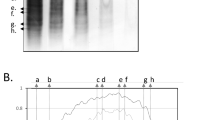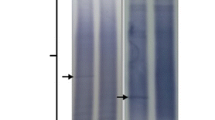Abstract
Oligoclonal immunoglobulin G bands (OCBs) restricted to the cerebrospinal fluid indicate intrathecal inflammation. Using isoelectric focusing and immunoblotting, they are detected in about 95 % of patients with clinically definite multiple sclerosis (MS). To elucidate whether in the remaining 5 % OCBs are truly absent or alternatively missed due to insufficient sensitivity of the routine measurement, we employed a new, highly sensitive nanoscale method for OCB detection. Capillary isoelectric focusing followed by immunological detection served to analyze OCBs in 33 well-characterized OCB-negative and 10 OCB-positive MS patients as well as in 100 OCB-negative control patients with non-inflammatory neurological diseases and 30 OCB-positive control patients with inflammatory neurological diseases. We detected intrathecal immunoglobulin G production in 10 out of 33 MS patients (30 %), initially diagnosed as being OCB-negative, and in all 10 OCB-positive MS patients, but in only 3 out of 100 non-inflammatory neurological controls (3 %) and in 29 of 30 inflammatory neurological controls (97 %). At least about one-third of MS patients without intrathecal immunoglobulin G synthesis according to standard methods are OCB-positive. Advanced methods for OCB detection may increase the analytical sensitivity for detecting OCB in patients with MS who are OCB-negative according to current routine methods.


Similar content being viewed by others
References
Stadelmann C, Wegner C, Bruck W (2011) Inflammation, demyelination, and degeneration—recent insights from MS pathology. Biochim Biophys Acta 1812:275–282
Weinshenker BG (1996) Epidemiology of multiple sclerosis. Neurol Clin 14:291–308
Compston A, Coles A (2008) Multiple sclerosis. Lancet 372:1502–1517
Freedman MS, Thompson EJ, Deisenhammer F, Giovannoni G, Grimsley G, Keir G, Ohman S, Racke MK, Sharief M, Sindic CJ et al (2005) Recommended standard of cerebrospinal fluid analysis in the diagnosis of multiple sclerosis: a consensus statement. Arch Neurol 62:865–870
Link H, Kostulas V (1983) Utility of isoelectric focusing of cerebrospinal fluid and serum on agarose evaluated for neurological patients. Clin Chem 29:810–815
Abraira V, Alvarez-Cermeno JC, Arroyo R, Camara C, Casanova B, Cubillo S, de Andres C, Espejo C, Fernandez O, Ferrer J et al (2011) Utility of oligoclonal IgG band detection for MS diagnosis in daily clinical practice. J Immunol Methods 371:170–173
Dobson R, Ramagopalan S, Davis A, Giovannoni G (2013) Cerebrospinal fluid oligoclonal bands in multiple sclerosis and clinically isolated syndromes: a meta-analysis of prevalence, prognosis and effect of latitude. J Neurol Neurosurg Psychiatry 84:909–914
Qin Y, Duquette P, Zhang Y, Talbot P, Poole R, Antel J (1998) Clonal expansion and somatic hypermutation of V(H) genes of B cells from cerebrospinal fluid in multiple sclerosis. J Clin Invest 102:1045–1050
Baranzini SE, Jeong MC, Butunoi C, Murray RS, Bernard CC, Oksenberg JR (1999) B cell repertoire diversity and clonal expansion in multiple sclerosis brain lesions. J Immunol 163:5133–5144
Colombo M, Dono M, Gazzola P, Roncella S, Valetto A, Chiorazzi N, Mancardi GL, Ferrarini M (2000) Accumulation of clonally related B lymphocytes in the cerebrospinal fluid of multiple sclerosis patients. J Immunol 164:2782–2789
Monson NL, Brezinschek HP, Brezinschek RI, Mobley A, Vaughan GK, Frohman EM, Racke MK, Lipsky PE (2005) Receptor revision and atypical mutational characteristics in clonally expanded B cells from the cerebrospinal fluid of recently diagnosed multiple sclerosis patients. J Neuroimmunol 158:170–181
Obermeier B, Mentele R, Malotka J, Kellermann J, Kumpfel T, Wekerle H, Lottspeich F, Hohlfeld R, Dornmair K (2008) Matching of oligoclonal immunoglobulin transcriptomes and proteomes of cerebrospinal fluid in multiple sclerosis. Nat Med 14:688–693
Owens GP, Bennett JL, Lassmann H, O’Connor KC, Ritchie AM, Shearer A, Lam C, Yu X, Birlea M, DuPree C et al (2009) Antibodies produced by clonally expanded plasma cells in multiple sclerosis cerebrospinal fluid. Ann Neurol 65:639–649
Obermeier B, Lovato L, Mentele R, Bruck W, Forne I, Imhof A, Lottspeich F, Turk KW, Willis SN, Wekerle H et al (2011) Related B cell clones that populate the CSF and CNS of patients with multiple sclerosis produce CSF immunoglobulin. J Neuroimmunol 233:245–248
Serafini B, Rosicarelli B, Magliozzi R, Stigliano E, Aloisi F (2004) Detection of ectopic B-cell follicles with germinal centers in the meninges of patients with secondary progressive multiple sclerosis. Brain Pathol 14:164–174
Ozawa K, Suchanek G, Breitschopf H, Bruck W, Budka H, Jellinger K, Lassmann H (1994) Patterns of oligodendroglia pathology in multiple sclerosis. Brain 117:1311–1322
Polman CH, Reingold SC, Banwell B, Clanet M, Cohen JA, Filippi M, Fujihara K, Havrdova E, Hutchinson M, Kappos L et al (2011) Diagnostic criteria for multiple sclerosis: 2010 revisions to the McDonald criteria. Ann Neurol 69:292–302
Tumani H, Deisenhammer F, Giovannoni G, Gold R, Hartung HP, Hemmer B, Hohlfeld R, Otto M, Stangel M, Wildemann B, Zettl UK (2011) Revised McDonald criteria: the persisting importance of cerebrospinal fluid analysis. Ann Neurol 70:520 (author reply 521)
Ferreira D, Voevodskaya O, Imrell K, Stawiarz L, Spulber G, Wahlund LO, Hillert J, Westman E, Karrenbauer VD (2014) Multiple sclerosis patients lacking oligoclonal bands in the cerebrospinal fluid have less global and regional brain atrophy. J Neuroimmunol 274:149–154
Franciotta D, Lolli F (2007) Interlaboratory reproducibility of isoelectric focusing in oligoclonal band detection. Clin Chem 53:1557–1558
Link H, Huang YM (2006) Oligoclonal bands in multiple sclerosis cerebrospinal fluid: an update on methodology and clinical usefulness. J Neuroimmunol 180:17–28
Halbgebauer S, Haussmann U, Klafki H, Tumani H, Wiltfang J, Otto M (2015) Capillary isoelectric focusing immunoassay as a new nanoscale approach for the detection of oligoclonal bands. Electrophoresis 36:355–362
Polman CH, Reingold SC, Edan G, Filippi M, Hartung HP, Kappos L, Lublin FD, Metz LM, McFarland HF, O’Connor PW et al (2005) Diagnostic criteria for multiple sclerosis: 2005 revisions to the “McDonald Criteria”. Ann Neurol 58:840–846
Teunissen C, Menge T, Altintas A, Alvarez-Cermeno JC, Bertolotto A, Berven FS, Brundin L, Comabella M, Degn M, Deisenhammer F et al (2013) Consensus definitions and application guidelines for control groups in cerebrospinal fluid biomarker studies in multiple sclerosis. Mult Scler 19:1802–1809
Zettl UKTH (2005) Cerebrospinal fluid and multiple sclerosis. Blackwell Publishing, Oxford
O’Neill RA, Bhamidipati A, Bi X, Deb-Basu D, Cahill L, Ferrante J, Gentalen E, Glazer M, Gossett J, Hacker K et al (2006) Isoelectric focusing technology quantifies protein signaling in 25 cells. Proc Natl Acad Sci U S A 103:16153–16158
Reiber H, Peter JB (2001) Cerebrospinal fluid analysis: disease-related data patterns and evaluation programs. J Neurol Sci 184:101–122
Stangel M, Fredrikson S, Meinl E, Petzold A, Stuve O, Tumani H (2013) The utility of cerebrospinal fluid analysis in patients with multiple sclerosis. Nat Rev Neurol 9:267–276
Kuhle J, Disanto G, Dobson R, Adiutori R, Bianchi L, Topping J, Bestwick JP, Meier UC, Marta M, Dalla Costa G et al (2015) Conversion from clinically isolated syndrome to multiple sclerosis: a large multicentre study. Mult Scler 21:1013–1024
Heussinger N, Kontopantelis E, Gburek-Augustat J, Jenke A, Vollrath G, Korinthenberg R, Hofstetter P, Meyer S, Brecht I, Kornek B et al (2015) Oligoclonal bands predict multiple sclerosis in children with optic neuritis. Ann Neurol 77:1076–1082
Brettschneider J, Tumani H, Kiechle U, Muche R, Richards G, Lehmensiek V, Ludolph AC, Otto M (2009) IgG antibodies against measles, rubella, and varicella zoster virus predict conversion to multiple sclerosis in clinically isolated syndrome. PLoS One 4:e7638
Petzold A (2013) Intrathecal oligoclonal IgG synthesis in multiple sclerosis. J Neuroimmunol 262:1–10
Jesse S, Brettschneider J, Sussmuth SD, Landwehrmeyer BG, von Arnim CA, Ludolph AC, Tumani H, Otto M (2011) Summary of cerebrospinal fluid routine parameters in neurodegenerative diseases. J Neurol 258:1034–1041
Wurster U, Stachan R, Windhagen A, Petereit HF, Leweke FM (2006) Reference values for standard cerebrospinal fluid examinations in multiple sclerosis. Results from 99 healthy volunteers. Mult Scler 12:62
Walsh MJ, Tourtellotte WW (1986) Temporal invariance and clonal uniformity of brain and cerebrospinal IgG, IgA, and IgM in multiple sclerosis. J Exp Med 163:41–53
Petereit HF, Reske D (2005) Expansion of antibody reactivity in the cerebrospinal fluid of multiple sclerosis patients - follow-up and clinical implications. Cerebrospinal Fluid Res 2:3
Acknowledgments
This work was supported by BMBF (German Federal Ministry for Education and Research): Kompetenznetz Multiple Sklerose (KKNMS), Kompetenznetz Neurodegenerative Demenzen (KNDD, FTLDc), and JPND projects: BIOMARKAPD, SOPHIA, FrontALS), Foundation of the State Baden-Wuerttemberg and the EU (NADINE) (Contract No. 246513). The work of MB, IB and AW was supported by a grant from Novartis for multiple sclerosis biomarker research. We especially thank our patients for participating in these studies and R. Aksamija for expert technical assistance.
Author information
Authors and Affiliations
Corresponding author
Ethics declarations
Conflicts of interest
The authors declare that they have no conflict of interest.
Ethical standards
All patients gave written informed consent for the use of remaining samples for research. This procedure and sample analysis for the purpose of this study was approved by the local Ethics Committees in Ulm and Würzburg in accordance with the Declaration of Helsinki.
Additional information
S. Halbgebauer and A. Huss contributed equally.
Electronic supplementary material
Below is the link to the electronic supplementary material.
Rights and permissions
About this article
Cite this article
Halbgebauer, S., Huss, A., Buttmann, M. et al. Detection of intrathecal immunoglobulin G synthesis by capillary isoelectric focusing immunoassay in oligoclonal band negative multiple sclerosis. J Neurol 263, 954–960 (2016). https://doi.org/10.1007/s00415-016-8094-3
Received:
Revised:
Accepted:
Published:
Issue Date:
DOI: https://doi.org/10.1007/s00415-016-8094-3




